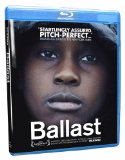| Reviews & Columns |
|
Reviews DVD TV on DVD Blu-ray 4K UHD International DVDs In Theaters Reviews by Studio Video Games Features Collector Series DVDs Easter Egg Database Interviews DVD Talk Radio Feature Articles Columns Anime Talk DVD Savant Horror DVDs The M.O.D. Squad Art House HD Talk Silent DVD
|
DVD Talk Forum |
|
|
| Resources |
|
DVD Price Search Customer Service #'s RCE Info Links |
|
Columns
|
|
|
Ballast
Ballast opens with two suicides: one successful, one not. Darius, a thirty-something heavy-set African American, did himself in with pills. Devastated by the loss, Lawrence (Michael J. Smith Sr.), Darius' identical twin, shoots himself in the heart, but lives.
Darius left behind a twelve-year-old son James (JimMyron Ross) that he hadn't seen since abandoning James' mom Marlee (Tarra Riggs) more than a decade earlier. There are no saints, nor villains among these principal characters. Darius left Marlee at Lawrence's urging, maybe because Marlee was a crack addict, maybe not. Marlee got a court order prohibiting Darius from seeing his son (on what grounds such an order was granted isn't revealed) and now works as a cleaning lady, a job which she hates but desperately needs. For his part, James has fallen in with the wrong crowd and is on the verge of becoming irredeemably lost to drugs and violence. Whether this surviving trio of characters will sink or float depends on whether they will be anchor or ballast for one another.
This summary of a plot about African Americans in dire straits may sound clichéd, and eyes may roll upon learning that the director is a white southern Californian without prior filmmaking experience, except as a CGI-artist on films such as Batman & Robin, but it'd be a mistake to discount this exceptional film on this account.
Hammer captured the directing award at Sundance for Ballast, and it's easy to see why. He masterfully synthesizes the best aspects of the Dardennes brothers' neorealism: real locations, available light, no extraneous soundtrack or score, handheld camerawork seemingly without premeditated blocking, naturalistic performances by non-professional actors, sparring narration, and a humanist concern for people on the socioeconomic margins.
The 35mm camerawork of cinematographer Lol Crawley, for which he captured the cinematography award at Sundance, is also remarkable. An opening scene in which Crawley literally runs after James through a sodden field forcefully removes any pretense at isolating distance between the observer and the observed, but once that point is made Crawley's camera settles down into mostly smoother pans as it follows events as they unfold. Though the images he captures always appear natural and fluid, Crawley consistently manages to frame the action just as the viewer would hope to do were he there in Crawley's stead; again not from the distanced perspective of a cinemagoer, but as an eyewitness.
Finally, something must be said about the remarkable performances elicited by Hammer from the non-professional cast. Using Mike Leigh's techniques for crafting performances through repetitive improvisation and sequential shooting, Hammer and his actors have created multi-faceted characters and dynamic interactions which seemingly could as easily end in violence as reconciliation.
Presentation
Video:
This 25GB single-layered 1080p Blu-ray release is MPEG-4/AVC encoded, and not region locked. It preserves the original 2.35:1 theatrical aspect ratio, and boasts a "director supervised high-definition digital transfer from the 35mm interpositive", Ballast probably looks nearly as good as it did in theaters. The washed-out blue-grey color palette looks consistent throughout, lines are sharp, and detail is fine. There's some grain and a bit of noise in the image, but nothing which is either distracting or seemingly attributable to the HD transfer.
Audio:
The Dobly TrueHD 5.1 mix sounds realistic. Dialogue can sometimes be faint matching the distance to the camera/observer, but, with the exception of James who frequently mumbles, is always comprehensible. Though naturalistic, the audioscape is exceptionally spare. Every sound from a bird call to a gun blast is grudgingly provided with nothing superfluous. The audio mix never outshines the visuals, but it serves ably.
Optional subtitles which should play below the 2.35:1 image on most setups are available in English, French, or Spanish.
Extras:
This release includes a fold-out booklet with an essay from film critic Amy Taubin, a theatrical trailer in HD, and a 37-minute featurette about scene development which follows several scenes from early rehearsals to final form.
Final Thoughts:
Lance Hammer's freshman film, Ballast, is a remarkable piece of neorealist filmmaking in the tradition of the Dardennes brothers. This spare, finely-crafted, humanist drama about three wounded souls fumbling their way through tragedy was one of the best independent American films of 2008, and makes for one of the best Blu-ray releases of this year.
|
| Popular Reviews |
| Sponsored Links |
|
|
| Sponsored Links |
|
|
| Release List | Reviews | Shop | Newsletter | Forum | DVD Giveaways | Blu-Ray | Advertise |
|
Copyright 2024 DVDTalk.com All Rights Reserved. Legal Info, Privacy Policy, Terms of Use,
Manage Preferences,
Your Privacy Choices | |||||||














